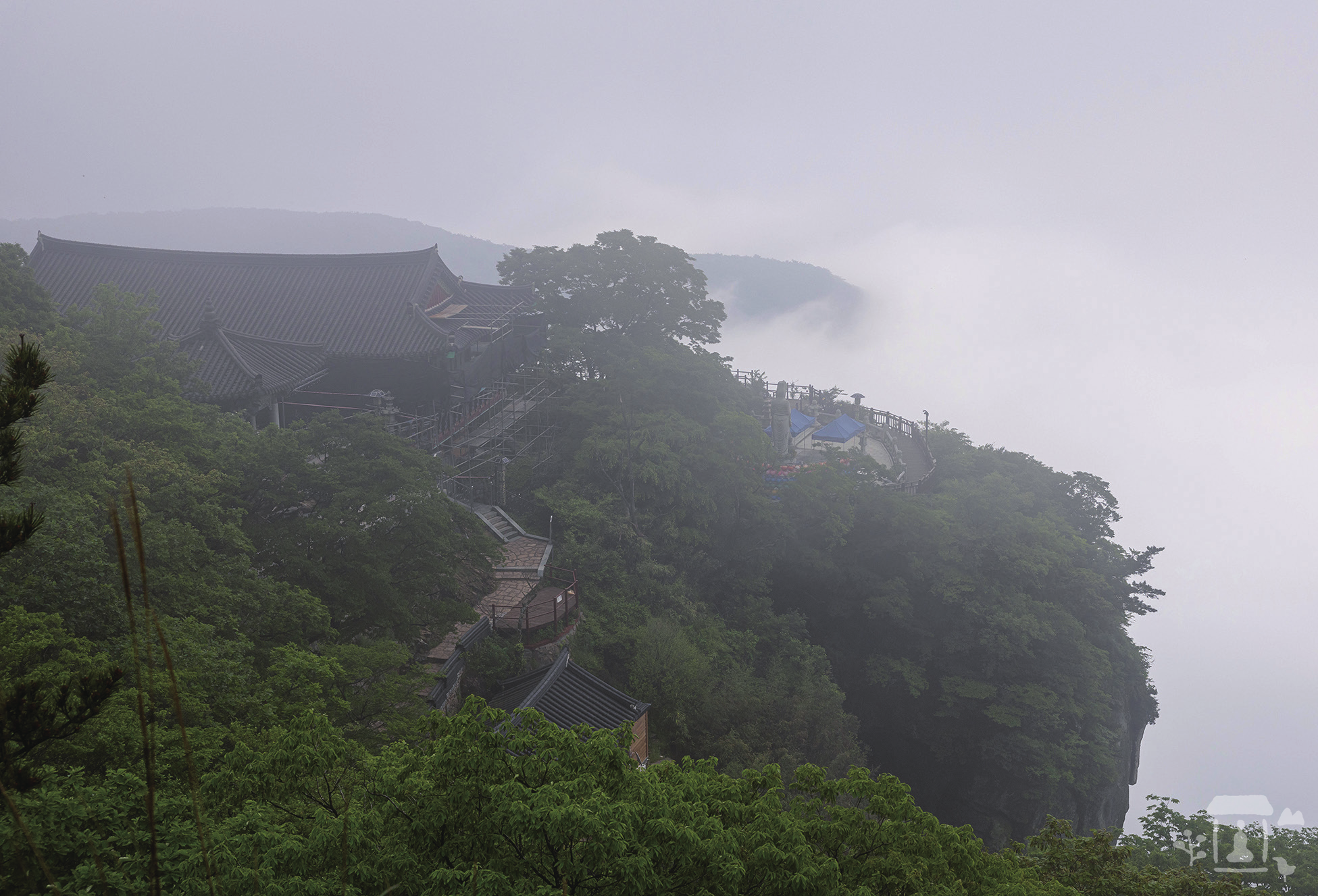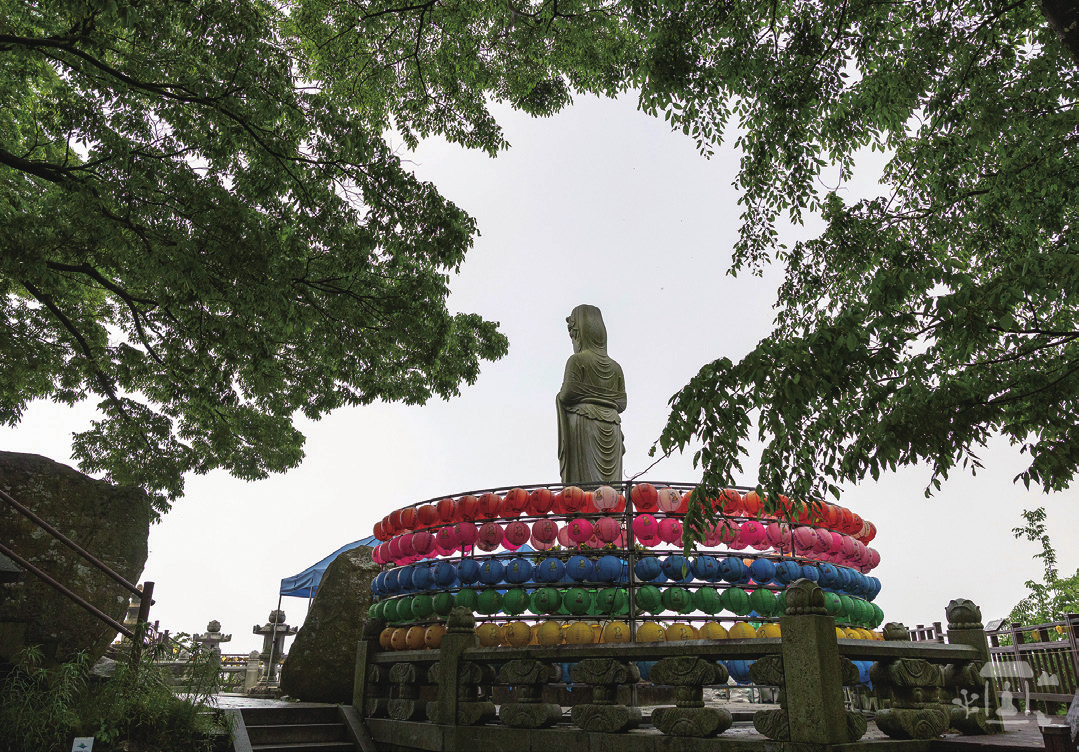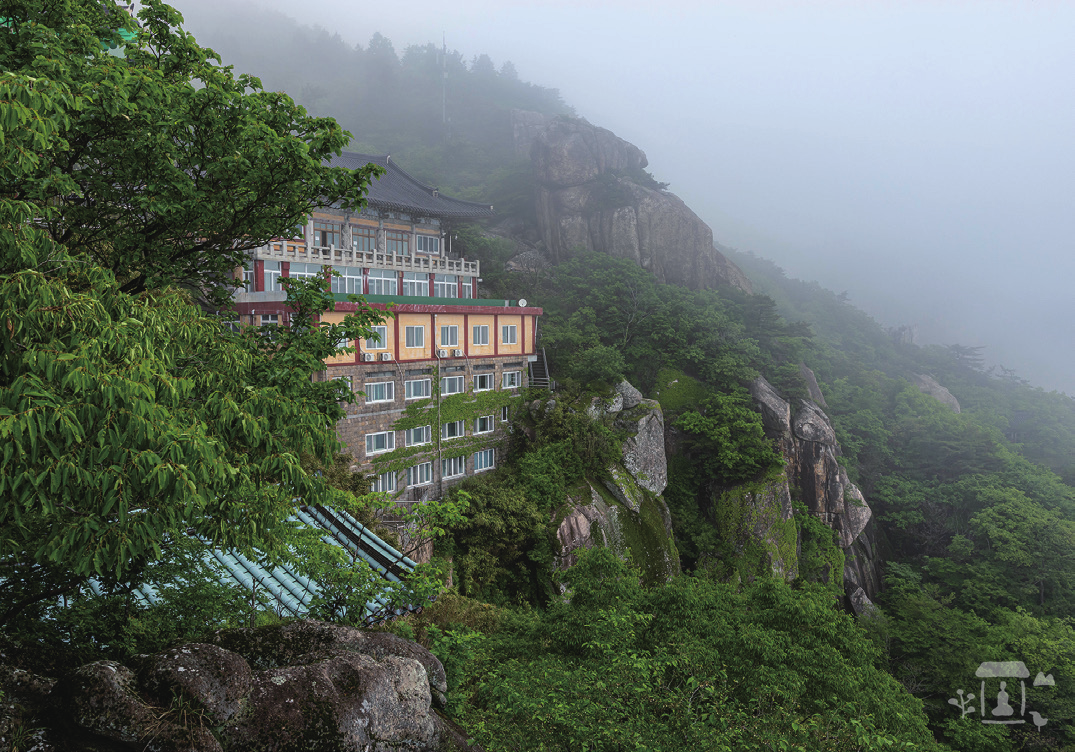A Pure Land Overflowing with Enlightenment
Bori-am Hermitage in Namhae
Something regarded small is big when compared to something smaller,
and something regarded big is small when compared to something bigger,
which is why discrimination is futile.
The Pure Land, where nothing is small or big, but all is one,
is unfolding here and now.
A minute particle of dust encompasses the ten directions,
and the compassion of Avalokitesvara Bodhisattva manifests
to those who see the universe in a single particle of dust.
Thanks to the love of non-self that wells up in your heart,
as soon as you realize the truth, you know that you and I are not separate.
Now, as I embark on a pilgrimage to the 33 Avalokitesvara temples,
compassion shines down from above upon my heart.
The love of Avalokitesvara Bodhisattva,
bright as the sun and limitless without any boundaries.


Does the mist fall from the sky or rise from the ground? I am in Namhae in Gyeongnam Province, and the forest path to Bori-am Hermitage is obscured by thick fog. The tree leaves are whitish, and the soil is dark as if covered by a film of twilight. Bori-am Hermitage is a beautiful sight, the blue sea rippling beyond rows of mountain ridges. The awesome scenery sweeps away the five defilements of the world, and is one of the reasons Bori-am is considered one of the major Korean temples dedicated to Avalokitesvara.
However, the fog erases this pilgrim’s expectations. Today, the unparalleled combination of lush forest and indigo ocean is not visible, so, on this foggy forest path, I naturally blame the sky and the ground for being unable to see them. The fog of discrimination suddenly blinds my heart.


1,350 Years of History
It is said that Master Wonhyo, who practiced on Mt. Geumsan, once saw a manifestation of Avalokitesvara Bodhisattva. Bori-am Hermitage was originally named Bogwangsa Temple, built by Wonhyo in 683. It is said that Yi Seong-gye performed a ritual here before founding the Joseon Dynasty in the 14th century, which enabled him to eventually ascend to the throne. In 1660, Joseon’s King Hyeonjong made Bogwangsa a prayer temple for deceased royalty and changed its name to Bori-am. The story of Yi Seong-gye is inscribed on the monument named Namhae-Geumsan Yeongeung Gijeokbi, which was erected near Bori-am in 1903. It says: “There is an altar where King Taejo performed a ritual below Samburam Hermitage, and when he ascended to the throne, he said that it looked like the mountain was covered with silk, so he named it Geumsan (lit. Silk Mountain).” Even then, Mt. Geumsan would have presented a spectacular view that could accurately have been described as a blessing from Avalokitesvara Bodhisattva.
Walking along the forest path, I come to Daejangbong Peak, so tall it appears as though it is about to take flight. Or perhaps it is just standing upright looking down at the foothills of Mt. Geumsan. Whatever your perspective, you sense it is the final majestic gate you must pass before entering a sacred realm. In addition to Daejangbong Peak, Bori-am Hermitage is surrounded on the east, west, and north by spectacular rock formations on Irwolbong, Jeseokbong, Hwaeombong, and Aegibong peaks, while toward the south, the terrain slopes gradually down to the sea. After passing Daejangbong Peak, you can leisurely enjoy the wide-open scenery under the watchful eyes of the surrounding peaks.
I catch my breath while resting beside Daejangbong Peak and step onto the man-made stairs leading to Bori-am Hermitage. Thick fog still envelopes Mt. Geumsan. The beautiful mountain, veiled in silklike fog, appears to be preparing to depart to some distant realm. Bori-am Hermitage has protected Mt. Geumsan for 1,350 years. In all that time, how many times has it summoned and dispelled the fog? To me, those many years seem to define a relationship destined to end with no regrets. My only regret is that the clock just keeps on ticking. The fog obscures my vision, and my steps feel heavy, but I push onward. From the top of the stairs, I see a pavilion below. The roof looks splendid bordered by oddly shaped rocks on the right and a small bamboo forest on the left. I finally feel that I have arrived at Bori-am Hermitage.
Anytime, Anywhere, the Pure Land
People often harbor great expectation in vain only to be equally disappointed. Forgetting the truth that all living beings are already inherently buddhas, people create and seek an imaginary world that is not reality. Since it is impossible to hold on to things, the act of seeking itself is suffering. However, as the 3rd Patriarch Sengcan said, “If you discard all thoughts, there is no place left to go.” I see the mist flowing over Bori-am Hermitage.



Once again, this pilgrim expected too much and was disappointed. I am speechless. Because of the fog, the distant sea is not visible, and instead, a sea of fog has risen over Bori-am. Miniscule water droplets floating in the wind cool my sweat. The southern mountain ridges appear and disappear quickly with the ebb and flow of the fog. Behind me, rocks wet with condensation create a mysterious atmosphere. It is a perfectly beautiful landscape that is neither lacking nor excessive. I joined my palms in front of the seaward-looking Avalokitesvara Bodhisattva, the primary goal of Bori-am pilgrimage, and the three-story stone pagoda next to it. I express my gratitude for the magnificence of the fog that has anointed countless pilgrims, and for the truth that all things are buddhas as they are, a truth that transcends the limits of language. My busy thoughts become quiet. The fog of discrimination disappears from my mind. There is now nowhere else for me to go. The distinct landscape of the sea embracing the myriad islands and the hazy landscape that makes it difficult to see ahead are all the blessing of Avalokitesvara Bodhisattva. When all is one, how can we not love all of creation? How can we forget the truth that “wherever we are is the Pure Land” is the blessing of Avalokitesvara Bodhisattva? The boundless, limitless, bright love of Avalokitesvara Bodhisattva, like the sun, continues to rise over Bori-am Hermitage.

Seaward-Looking Avalokitesvara Bodhisattva Statue and the Three-story Stone Pagoda
Upon close examination, we see that the Bodhisattva’s left hand holds a jeweled vase, the right hand rests on the chest, and the hem of the robe is delicately expressed, all of which harmonize well with the surrounding scenery of Bori-am Hermitage. Thanks to the fact that everyone who goes to Bori-am never fails to visit the statue, it has become an iconic symbol of Bori-am. One story says the threestory stone pagoda standing next to the Avalokitesvara Bodhisattva was made with stones brought from India by Queen Heo Hwangok—Princess Suriratna of Ayodhya—who married King Kim Su-ro of the Geumgwan Gaya Kingdom. Another story says it was built by Master Wonhyo to commemorate the founding of the temple, but based on an analysis of the construction style, it is presumed to be a stone pagoda from the early Goryeo era

Bogwangjeon and Geungnakjeon Halls
Bogwangjeon, Bori-am’s main buddha hall, was built in 683. It enshrines a wooden seated Avalokitesvara Bodhisattva statue, which is enshrined in a cabinet flanked by statues of Sudhana and the Dragon King. Judging from the plump cheeks and the hems of the robe hanging on both sides, the statue is believed to be from the late Joseon Dynasty. Behind Bogwangjeon is Seokbuljeon Hall, a grotto in which a statue of Buddha is enshrined. This site is so amazing that people line up to pay their respects here. Measuring five bays across the front and three bays along the sides, Geungnakjeon is the largest of all Bori-am’s buildings. Geungnakjeon was built on a steep slope, a feat which amazes visitors; it is also a popular spot for taking photos. The view of Geungnakjeon and the Dadohae Archipelago together is amazingly beautiful.

Rock Inscriptions
Climbing up and down Mt. Geumsan feels like you are on a treasure hunt. This is because there are rock inscriptions in about 70 places. These are writings or pictures carved into the rocks, which are related to individuals’ daily lives and major events. These are valuable research materials for the eras in which they were carved. In order to inform the public about these inscriptions, the Hallyeohaesang National Park Office developed a QR code program in 2023 and posted it in various places. Travelers can take a picture of the QR code near each inscription with their smartphones and instantly check the Chinese character pronunciation, Korean translation, and their explanations.






